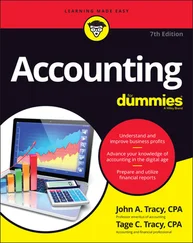Kenneth W. Boyd - Cost Accounting For Dummies
Здесь есть возможность читать онлайн «Kenneth W. Boyd - Cost Accounting For Dummies» — ознакомительный отрывок электронной книги совершенно бесплатно, а после прочтения отрывка купить полную версию. В некоторых случаях можно слушать аудио, скачать через торрент в формате fb2 и присутствует краткое содержание. Жанр: unrecognised, на английском языке. Описание произведения, (предисловие) а так же отзывы посетителей доступны на портале библиотеки ЛибКат.
- Название:Cost Accounting For Dummies
- Автор:
- Жанр:
- Год:неизвестен
- ISBN:нет данных
- Рейтинг книги:4 / 5. Голосов: 1
-
Избранное:Добавить в избранное
- Отзывы:
-
Ваша оценка:
- 80
- 1
- 2
- 3
- 4
- 5
Cost Accounting For Dummies: краткое содержание, описание и аннотация
Предлагаем к чтению аннотацию, описание, краткое содержание или предисловие (зависит от того, что написал сам автор книги «Cost Accounting For Dummies»). Если вы не нашли необходимую информацию о книге — напишите в комментариях, мы постараемся отыскать её.
Cost Accounting For Dummies
Cost Accounting For Dummies
Cost Accounting For Dummies — читать онлайн ознакомительный отрывок
Ниже представлен текст книги, разбитый по страницам. Система сохранения места последней прочитанной страницы, позволяет с удобством читать онлайн бесплатно книгу «Cost Accounting For Dummies», без необходимости каждый раз заново искать на чём Вы остановились. Поставьте закладку, и сможете в любой момент перейти на страницу, на которой закончили чтение.
Интервал:
Закладка:
Profit = $18 × (12,500) – $8 × (12,500) – $15,000
Profit = $225,000 – $100,000 – $15,000
Profit = $110,000
Trouble is, the increased number of units sold sent the total variable cost up, but variable cost is better covered by the moderate increase in sales and a big reduction in fixed costs.
Combining the results of two products
The sales mix is the relative proportion in which a company’s products are sold. Most companies sell more than one type of the same product. For example, say you sell shirts. Forty percent of your sales are long-sleeve dress shirts, and 60 percent of your sales are short-sleeve golf shirts. The sales mix is 40 percent long-sleeve and 60 percent short-sleeve.
To use cost-volume-profit analysis effectively, apply the methodology to more than one product at a time. You want to see how multiple products are contributing to your profit goal. Strictly speaking, these are product types. You don’t have to know the numbers for every color, size, and style of shirt.
Good news! If one product produces less profit (because of low sales), the other product could potentially make up for it. Ideally, you can adjust your sales between products to maintain the total profit you want. If dress shirt sales are lagging, you can sell more golf shirts.
Applying breakeven point to two products
To plan your sales and profits, it’s ideal for you to know the breakeven point for every product type you sell. So if you have a store that sells just two product types, compute the breakeven points for both of them.
Say you manage a lumberyard that sells two types of wood to furniture makers: Pristine wood and Sturdy wood. A unit is one board of wood. (If you’re selling first-class hardwoods, the sample prices are pretty close to reality. There’s some serious money in a board  of an inch thick, 10 inches wide, and 40 inches long.)
of an inch thick, 10 inches wide, and 40 inches long.)
Pristine wood is used to make beautiful tabletops and sells for $50 per unit. Variable costs are $30 per unit, and fixed costs total $30,000. The breakeven formula is
Profit ($0) = sales – variable costs – fixed costs
Profit ($0) = (units × $50) – (units × $30) – $30,000
Profit ($0) = units × ($50 – $30) – $30,000
Profit ($0) = units × $20 – $30,000
To finish the calculation, add $30,000 to both sides of the equation. Then divide both sides by $20:
$30,000 = units × $20
$30,000 / $20 = units
1,500 = units
You sell 1,500 units of Pristine wood to break even.
Sturdy wood is used to make pretty good tabletops and sells for $25 per unit. Variable costs are $18 per unit, and fixed costs total $25,000. Here’s the breakeven formula:
Profit ($0) = sales – variable costs – fixed costs
Profit ($0) = (units × $25) – (units × $18) – $25,000
Profit ($0) = units × ($25 – $18) – $25,000
Profit ($0) = units × $7 – $25,000
To finish the calculation, add $25,000 to both sides of the equation. Then divide both sides by $7:
$25,000 = units × $7
$25,000 / $7 = units
3,572 = units
You sell 3,572 units of Sturdy wood to break even.
Pristine wood’s breakeven point in units is less than half of the Sturdy wood’s (1,500 units versus 3,571 units).
A contribution margin of $20 (Pristine wood) beats a contribution margin of $7 (Sturdy wood) any day of the week. The difference in fixed costs is $5,000 — not a big difference. Pristine has a much larger contribution margin to cover fixed costs. That’s why Pristine wood’s breakeven point is so much lower.
Applying target net income to two products
After you compute the breakeven points on two products, you can decide on target net income for the period. Assume again that you sell Pristine and Sturdy wood, and your target net income for both types of wood is $10,000. You target a $5,000 profit for each product type.
Pristine wood’s calculation is
$5,000 = sales – variable costs – fixed costs
$5,000 = (units × $50) – (units × $30) – $30,000
$5,000 = units × $20 – $30,000
Finish the calculation, and you see that it takes 1,750 units of Pristine wood to reach target net income of $5,000.
For Sturdy wood, plug in the variables. You need to sell 4,286 units to reach target net income.
The total profit for both products is $10,000 ($5,000 + $5,000).
Adjusting product sales to reach target net income
If one product’s sales are lower than planned, you can still reach your target net income. Higher sales in one product can make up for lower sales in another product.
For example, say the economy is bad, and customers aren’t eager to buy Pristine wood, so you sell only 1,600 units. The profit calculation is
Profit = $50 × (1,600) – $30 × (1,600) – $30,000
Profit = $80,000 – $48,000 – $30,000
Profit = $2,000
Your target net income for Pristine wood is $5,000, so you’re $3,000 short of your goal. To reach your total target net income, maybe you can shift that $3,000 profit “burden” to Sturdy wood.
To determine how much more you need to sell, just change the Sturdy wood profit to $8,000, and compute the new number of units sold:
$8,000 = (units × $25) – (units × $18) – $25,000
$8,000 = units × $7 – $25,000
Finish the calculation. The number of units to reach your profit goal is $33,000 divided by $7. Therefore, if you sell 4,715 units of Sturdy wood, you generate $8,000. Your total target net income of $10,000 is based on $2,000 from Pristine wood and $8,000 from Sturdy wood.
Costing and pricing a new product
Financial planning for a new product is really difficult, because so many variables are unknown. Product costs, prices, and units sold are based mainly on research and management’s business experience. In spite of these challenges, many businesses successfully launch new products. With careful thought and proper planning, you can introduce a new product and earn a decent profit.
 Finding and retaining great employees is the key to growing a successful business. Your best workers make smart decisions that increase profits and sales. Those decisions can lower costs, close a customer sale, or make a process run more smoothly. In short, you can’t operate a profitable business without a great staff, so do what you can to keep your workers happy.
Finding and retaining great employees is the key to growing a successful business. Your best workers make smart decisions that increase profits and sales. Those decisions can lower costs, close a customer sale, or make a process run more smoothly. In short, you can’t operate a profitable business without a great staff, so do what you can to keep your workers happy.
Starting with your product idea
The best products and services solve an urgent problem for a customer. Want an example? I’m charging my iPhone using a portable charger, because my power is out at home. That’s my definition of solving an urgent problem!
 Successful business owners are realistic. They understand that finding the best product idea takes time, and that customer feedback can uncover an urgent need. Some of the biggest names in business have pivoted to a new product or service, when the first few ideas didn’t work. To learn more about business pivots, check out Chapter 5.
Successful business owners are realistic. They understand that finding the best product idea takes time, and that customer feedback can uncover an urgent need. Some of the biggest names in business have pivoted to a new product or service, when the first few ideas didn’t work. To learn more about business pivots, check out Chapter 5.
OK, it’s time to find that super useful product idea…
Assume that you manufacture and sell mountain bikes and outdoor gear. Your customers are serious riders, who head out on rides in every kind of weather. To understand customer needs, you document customer services calls and conduct frequent surveys. What trends do you notice?
Читать дальшеИнтервал:
Закладка:
Похожие книги на «Cost Accounting For Dummies»
Представляем Вашему вниманию похожие книги на «Cost Accounting For Dummies» списком для выбора. Мы отобрали схожую по названию и смыслу литературу в надежде предоставить читателям больше вариантов отыскать новые, интересные, ещё непрочитанные произведения.
Обсуждение, отзывы о книге «Cost Accounting For Dummies» и просто собственные мнения читателей. Оставьте ваши комментарии, напишите, что Вы думаете о произведении, его смысле или главных героях. Укажите что конкретно понравилось, а что нет, и почему Вы так считаете.












